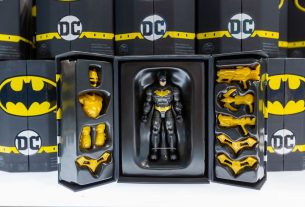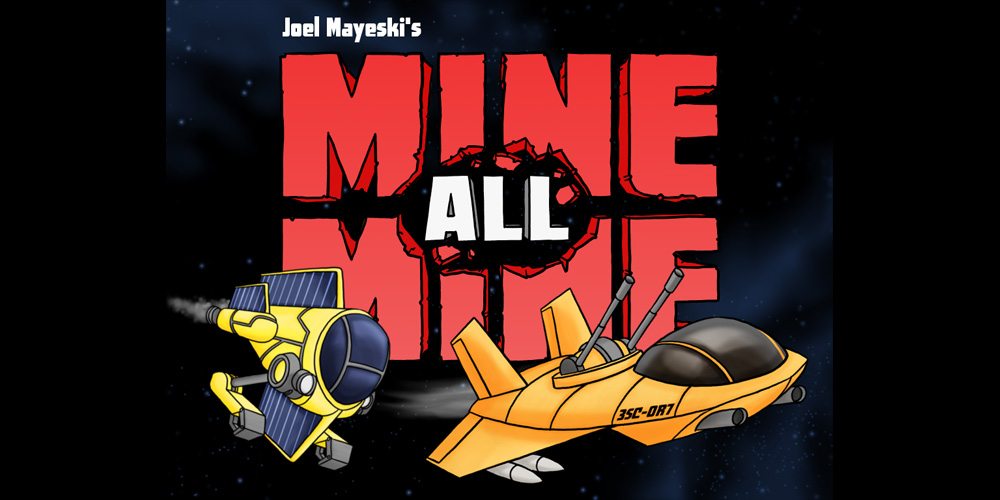The Ravensburger game Disney Villainous is back with another sequel with three new baddies for you to put against each other or against any of the other villains from the prior sets. And at long last, the villain every fan of the game has been waiting for is here.
What Is Disney Villainous: Despicable Plots?
Disney Villainous: Despicable Plots is a game for 2-3 players, ages 10 and up, and takes about 40 minutes to play. It’s currently available just about everywhere, retailing for $24.99.
Note: as an Amazon affiliate, I earn with qualifying purchases.
The game was designed by Mike Mulvihill, based on the Villainous Game System designed by Prospero Hall.
Despicable Plots Components

Inside the box, you’ll find:
- 3 Villain Movers
- 3 Player Boards
- 3 Villain Decks, each with 30 cards
- 3 Fate Decks, each with 15 cards
- 55 cardboard tokens
- 1 Black Cauldron tile
- 3 Villain Guides
- 3 Reference Cards
The components in this set are mostly identical to those in the both the base Villainous game and the prior sequels. The Power Tokens and Fate Token (to be used in 4-6 player games when you are mixing this with either of the other titles in the series) are absolutely the same as before. The Villain Decks, Fate Decks, and Villain Guides obviously have pictures and text unique to these characters, but design-wise they are the same as those included in the other sets.
This sequel does include a special Black Cauldron tile for use with the Horned King. More on that in a bit.
As always, one of the more visually interesting design elements throughout the Villainous franchise is the movers. Rather than going with miniatures or cardboard standees of the characters, the game’s designers came up with these really cool abstract models. Each is totally unique, and yet so well thought-out that they are obviously the character they represent.
Despicable Plots‘ villains are the aforementioned Horned King from the 1985 film The Black Cauldron, Lady Tremaine from 1965’s Cinderella, and, at long last, Gaston, from 1991’s Beauty and the Beast.

The Horned King’s mover is green, with the villain arising out of the titular cooking vessel. Lady Tremain’s mover is a pale blue representation of her hair (and watch closely when you play, as you’ll definitely be tempted to look at this one backwards). And Gaston, in an orangish yellow, has his puffed-out chest and quiver of arrows.


This iteration does not introduce any mjor new mechanics, so players of the original or any of the other sequels will be able to jump right in. The Horned King’s cauldron tile is a “relic”, which is kind of different, but not too hard to wrap your head around.
How to Play Despicable Plots
The basic rules of Perfectly Wretched are the same as in the base Villainous game and the other sequels. It’s important to note that Ravensburger wants us to refer to the game as a sequel rather than an expansion, and that’s not just marketing mumbo-jumbo since expansion implies that the original game is required to play. Like Wicked to the Core, Evil Comes Prepared, and Perfectly Wretched, Despicable Plots is a stand-alone game. It includes everything needed to play with just these three Villains. However, it can also be freely combined with any Villains from either Disney Villainous, Wicked to the Core, Evil Comes Prepared, or Perfectly Wretched, and thus played with up to 6 players. (I should point out that at this point there are now 18 Villains in the game, and if you own all five sets, you do in fact have enough pieces to play with all 18 at once. The designers, however, keep insisting that the limit is 6, and this is wise. The downtime between turns is already pushing the limit that most players would be willing to endure at 6 players. At 18, it’d become very boring very quickly.)
The detailed rules of how to play were already covered in Jonathan Liu’s original review of Villainous. If you’re unfamiliar with the game, I’d recommend you pause and go read that review, as I will not be going into those details here. Instead, I’m just going to go over what is unique about the Villains in this set. If you are interested in the Villains included in the other sequels, check out my reviews of Wicked to the Core, Evil Comes Prepared, or Perfectly Wretched.
Gaston

We’ll start with the one everyone will be excited to play: Gaston. After all, no one plays like Gaston, no one wins like Gaston, no one villains in Villainous quite like Gaston. (Sorry/not sorry for getting that stuck in your head.)
To win, Gaston has to remove all of the obstacles that stand in his way of marrying Belle. At set up, you take the eight Obstacle tiles and place two in each of Gaston’s locations in his Realm. Obstacles can be removed through event cards and the ally Monsieur D’Arque. Vanquishing Beast and Maurice does the trick, too. However, many of the cards in Gaston’s fate deck will replace obstacles, and while Belle is place, no obstacles can be removed at all.
It’s also worth noting that unlike many Villains, who must have achieved their goal at the beginning of their turn, Gaston wins immediately when the last obstacle is removed.
Lady Tremaine
One might argue that the villain from one of earliest Disney Princess movies would be more highly anticipated than Gaston, but let’s be honest: “This is the name of Cinderella’s evil step mother” is a hard Jeopardy question.

Tremaine’s objective is the exact one she had in the movie: marry one of her daughters to the Prince. To do this, she needs to get the Prince in play from her Fate deck, unlock the Ballroom, and get either Ball Gown Drizella or Ball Gown Anastasia to the Ballroom. Once there, you activate the Wedding Bells card. Like Gaston, Tremaine can win at any point in her turn.
The only special setup for Tremaine is placing a lock token on the Ballroom, which is something that is done with many other Villains throughout the franchise. Tremaine plays an Invitation from the King card to unlock the ballroom, and there are no cards in either deck that relocks it.
What is unique about the Ballroom is that unlike any other location in any realm in the game, you cannot freely play cards there. Instead, only four cards can be played: The Price (who must be played there when he’s revealed), Ball Gown Cinderella, Ball Gown Drizella, and Ball Gown Anastasia.
Also unique is the presence of two versions of characters: there is a “regular” Drizella, “regular” Anastasia, and “regular” Cinderella, and then there are “ballgown” versions of each. Two versions of the same character cannot be in play at once, and none of the “ballgown” versions can enter play unless the “regular” version is already there and can be discarded. The only exception is that the Fairy Godmother can play Ballgown Cinderella directly.

And one more thing that makes Tremaine a bit different from other villains: she has no Vanquish actions. Instead, she “traps” Heroes using her cards, which negates whatever ability the Hero might have. She also has a few cards that will allow her to discard or defeat cards in play from her Fate deck.
One final note: the Prince card is a Prince, not a Hero, and is thus immune from all cards that target Heroes.
Horned King
Growing up, I loved the fantasy books by Lloyd Alexander, and while I was probably a bit too old to really enjoy the animated film Disney eventually made based on the book, I am still quite familiar with the Horned King.

On setup, the player takes the The Black Cauldron tile and places it near his realm. It’s a Relic, a special type of token that no other villain in the game has (yet). In order to win, the King needs to claim the Cauldron, power it, and then use its power to change Ancient Soldier allies to Cauldron Born. Once you have a Cauldron Born in each location in your realm, you win. As with the other two Villains in this set, the King can win at any point on his turn.
The King has three cards in his deck that allow him to claim the Cauldron. Once one of these is played, he takes the tile and places it above the portrait on his player board. The Cauldron can be activated by playing a particular card, or by simply using an Activate action. However, the King’s realm does not contain any Activate actions, so he will first need to get out at least one Ancient Soldier card, which will add Activate actions.
Converting Ancient Soldiers to Cauldron Born requires that the Cauldron be activated (something that can be undone by a couple of Fate cards), and then, before moving to a new location, the King can pay two power to discard an Ancient Soldier and replace it with a Cauldron Born. (It’s worth noting that if the other players get one of those Fate cards that unpowers the Cauldron, the King will need to activate it again, but remember that his only activation actions come from those Ancient Soldiers his is discarding to get Cauldron Born.)
Why You Should Play Despicable Plots
As with the other sequels, Despicable Plots keeps moving the Villainous franchise forward by adding new twists to the game. Even though the original design team at Prospero Hall is no longer involved with the game, they built such a solid system that new designers continue to come in and build on top of it in ways that make each sequel not only unique in itself, but also fit perfectly with the others. That’s no small feat.
Of the three villains in this sequel, Tremaine has emerged as the most difficult to win with, followed by Gaston and the Horned King. Not being able to easily vanquish heroes, along with having so many steps to achieve the goal, makes Tremaine a character one should only play once you are familiar with the game. And be prepared to lose quite a lot before you really figure out the nuances and develop a strategy to win.
And that above is what makes this game so intriguing, and makes it one worth coming back to over and over. There are certainly optimal strategies for each character, but those are rarely apparent at first glance, and often take multiple plays to really discover. But the game also includes several layers of luck, as the player does need to draw the right cards at the right time, and their opponents make get lucky by drawing just the right Fate card to spoil their plans.
Of course, Ravensburger is no doubt far from done with the Villainous series. Disney still have a deep vault of untapped villains they can bring into the game, and I’m still holding out hope for them to bring us Star Wars Villainous at some point. But until they do, I’ll keep playing and enjoying Disney Villainous and looking forward to its next sequel.
Despicable Plots is available in stores and online now.
Click here to see all our tabletop game reviews.
![]() To subscribe to GeekDad’s tabletop gaming coverage, please copy this link and add it to your RSS reader.
To subscribe to GeekDad’s tabletop gaming coverage, please copy this link and add it to your RSS reader.
Disclosure: GeekDad received a copy of this game for review purposes.





